Loch flies
{{start}}
Loch Style fly-fishing involves fly-fishing from a boat, side onto the wind, using a system incorporating one or a number of flies. There are both wet and dry lock style fishing techniques. There are four distinct sub sections of loch flies: wake or bob flies, dropper flies that can be placed in various position s in a team of flies for different effects, attractor flies which are generally fished on a middle dropper and point flies.
The dry fly technique involves casting out in the direction of the drift, stopping the cast above the water so as to let the team of flies settle, waiting the desired time (often only 5 to 10 seconds) and then repeating the process in a slightly different position. Dry fly Loch style fly fishing covers a lot of water in a short time. The flies used are ordinary dry flies such as those shown in the dry fly page of this website. When selecting a team of flies try to balance the selection so that the most aerodynamic fly is on the point and the least aerodynamic fly is on the top dropper.
The wet technique involves casting out in the direction of the drift, fishing the flies using a range of techniques. Wet fly loch fly fishing, as well as incorporating a range of different retrieves and fly lines ranging from floating right through to very fast sinking lines can also involve fishing: the drop, the retrieve, the stop, the lift, the hang and the dibble and the dapple.
{{end}}
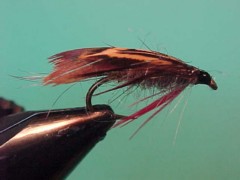
{{+1}}Murdoch{{-1}}
{{start}}
Another old fly this little beauty has its origins on the salmon and trout streams of Ireland probably around the 1820's. Its alternative name of 'hares ear and red' gives away its ancestry. Early versions of the fly presented were no more than a gold ribbed hares ear with a woodcock type wing tied on top. Over time the recipe has evolved.{{end}}

{{+1}}Dunkeld – Chatto’s fuzzeled variant{{-1}}
{{start}}
The Dunkeld is certainly one of my top 5 middle dropper flies for lock style fly fishing. Until 18 months ago I was using a version of the Dunkeld that had a hackle Palmered along the body as in the original. At that time I was experimenting with "fuzzeled" bodies an an alternative to bodies with a Palmered hackle and applied that technique to this fly with immediate success.{{end}}
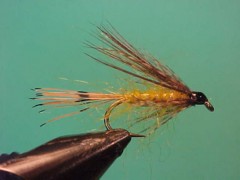
{{+1}}Bredbo variant MK2 – Chatto’s original{{-1}}
{{start}}
The MK2 is a great alternative middle dropper lock fly to my tie of a Dunkeld for those bright full sun days and also a very formidable wee wet for faster or discoloured rivers.{{end}}
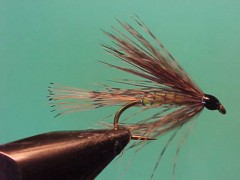
{{+1}}Bredbo variant MKI – Chatto’s original{{-1}}
{{start}}
The Bredbo fly is accredited as being the first Australian designed and made fly and whilst the originator is not known with certainty there is highly persuasive evidence that suggests that it was conceived around 1896 as a grass hopper imitation for targeting fish on the Bredbo river just outside of Cooma NSW. The evidence points to the fly being created by Mr C.R. Burnside and Dr A.J. Brady who along with Howard Joseland are amongst the pioneers of fly fishing for trout in New South Wales .{{end}}
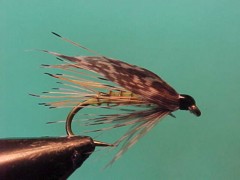
{{+1}}Bredbo{{-1}}
{{start}}
o here you have a fly that fishes well as a formidable traditional river wet fly is now vying for a position as a very effective middle dropper for loch style fly fishing ... and its only a couple of hundred years old. One of my favourite flies in that situation is a Dunkeld and over the last two seasons I have found the Bredbo to be a very comfortable alternative particular in summer months when fish are turned onto the wing colour of the dominant local grass hopper the yellow winged hopper.{{end}}

{{+1}}Sparkle bugger{{-1}}
{{start}}
Woolly buggers and their variants would have to be close to the quintessential wet fly. This woolly bugger version is one of my favourate late season still water flies.{{end}}
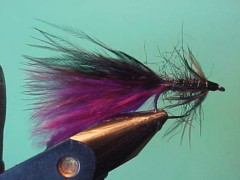
{{+1}}Tassi bugger – Chatto’s version{{-1}}
{{start}}
I was introduced to this variation in the lead up to the 2002 Tasmanian One Fly which by chance I won. Whilst I was not comfortable enough to use this fly in that contest I have used it many times since to great effect.{{end}}
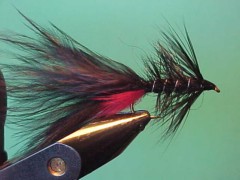
{{+1}}Mark II woolly bugger{{-1}}
{{start}}
The MK 2 woolly buggers evolved from standard black and olive woolly buggers as a fly that would imitate an American frog that had bright red between its hind legs. The red is a great trigger point and I find the MK2 as a great generalist search pattern. In southern climes the hot spot is tied in any of the 'roe' colours and is widely accepted as one of the best early season search pattens.{{end}}
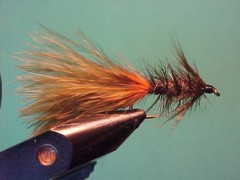
{{+1}}Skirted woolly bugger – Chatto’s original{{-1}}
{{start}}
Whilst not tied to imitate any natural food source it's a very buggy looking fly with heaps of trigger points including the marabou tail, the soft body and front hackles as well a the skit itself. In particular I like to incorporate blood red or orange skirts which are suggestive in the case of a red skirt as bleeding from around the base of the tail or the claws depending on what the fly is taken as or in the case of an orange skirt as a fish roe.{{end}}
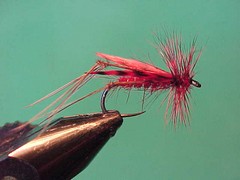
{{+1}}Claret daddy{{-1}}
{{start}}
This is a cross between an English claret hopper and a daddy long legs fly and it fills a gap in my fly box for a buggy looking search pattern when there are a few terrestrials about but no clear consistency of species. Because of its size and the way that it floats this fly is also useful as a top fly when either Loch Style Dry Fly fishing or as an indicator when fishing a team of dry smut flies or other small flies.{{end}}













